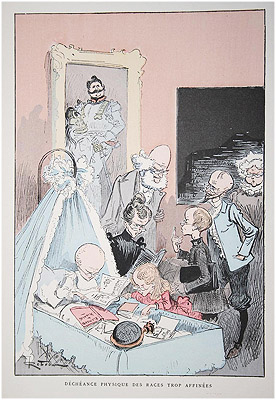![]()

French Racial Cartoon, source blacque jacques
Francis Galton, a cousin of Charles Darwin, espoused the theory that the human race could be improved by its fittest specimens reproducing at a higher rate, naming his philosophy Eugenics in 1883. Galton asserted that in order for a society to thrive, those who were, by nature of birth, better positioned to succeed, should be encouraged to pass on their superior genes (Wikipedia, n.d.). Conversely, those who were not predetermined to be successful members of society, whether deemed feeble-minded, immoral, degenerate, or criminal, should be prevented from perpetuating their genetic weaknesses into future generations. This prevention is known as negative eugenics. It encompasses a fairly broad spectrum of those considered “socially inadequate” (Lombardo, n.d.), including people afflicted with alcoholism, epilepsy, mental illness, syphilis, or just a history of poverty. Eugenicists believed that individuals demonstrating these traits were less fit to contribute to society in a meaningful manner and that their progeny would fare no better. Instead, they were all likely to be an active drain on society, particularly on the government coffers (Wikipedia, n.d.).
![]()
In 1907, Indiana was the first state to pass a eugenics law which legalized involuntary sterilization of the “feeble-minded” (Lombardo, n.d.). California followed suit in 1909 and even went a step further, legalizing the asexualization (Abate, 2003) of individuals with more than three criminal convictions, the feeble-minded, and prison inmates “exhibiting sexual or moral perversions” (Abate, 2003). This allowed vasectomies to be performed on men and tubal ligations on women, as well as male castration and female oopherectomy, in order to guarantee their inability to reproduce (Abate, 2003).
Positive eugenics (Carlson, n.d.) supports the selective breeding of human beings who are deemed to be the most intelligent and accomplished among society; they were strongly encouraged to produce large families. During the 1920’s, state fairs frequently hosted contests called Fitter Families for Future Firesides (Eugenics Archive, n.d.), commonly known as Fitter Family contests. The first was held at a state fair in Kansas in 1920. Families would enter the competition to be judged, based on a questionnaire they were required to submit, and individual medical examinations, which evaluated both physical and psychological health. The family scoring highest overall won the grand prize, a silver trophy. The runners up, scoring an average of at least a B+, won a medal inscribed with the words, “Yea, I have a goodly heritage” (Eugenics Archive, n.d.). The winners were often photographed and interviewed for the local newspaper, minor celebrities with their genetic superiority publicly validated.
Germany’s Adolf Hitler tasked his government with devising a full-fledged eugenics or “race hygiene” (Eugenics Archive, n.d.) program. After instituting laws allowing involuntarily sterilization of the unfit, and marriage laws prohibiting unions among certain categories of people (to prevent procreation), Germany’s doctors moved on to outright murder by 1940. At that time, they began gassing institutionalized mental patients, resulting in more than 70,000 deaths (Eugenics Archive, n.d.). This occurred prior to the even larger scale atrocities and mass murder of Jews, gypsies, and others in Nazi concentration camps during the years of World War II.
References
- Tom Abate, State’s Little-Known History of Shameful Science: California’s Role in Nazis’ Goal of Purification. Retrieved August 19, 2008
- Elof Carlson, Scientific Origins of Eugenics. Retrieved August 18, 2008
- Fitter Family Contests. Retrieved August 18, 2008
- Paul Lombardo, Eugenic Sterilization Laws. Retrieved August 19, 2008
- Eugenics
- For extra credit please suggest to your instructor any other relevant website for this topic. Send the title of the site, the URL and a brief explanation why you find the information interesting and applicable to the material being studied this week.